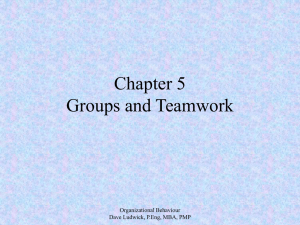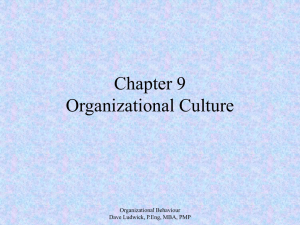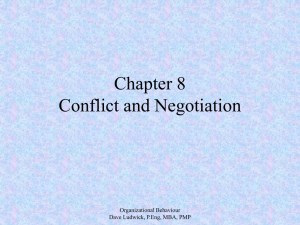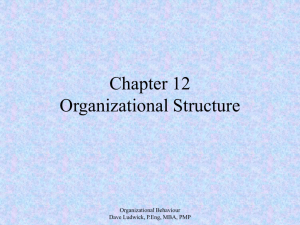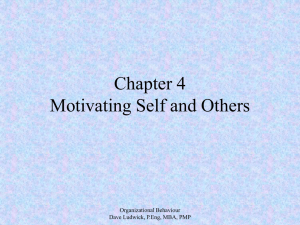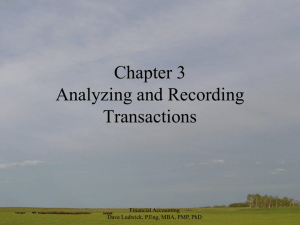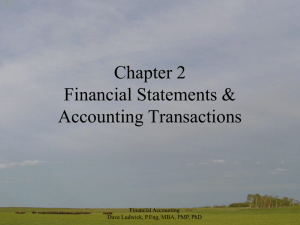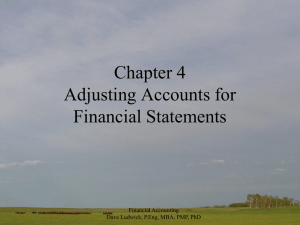Organizational Behaviour Chapter 13
advertisement
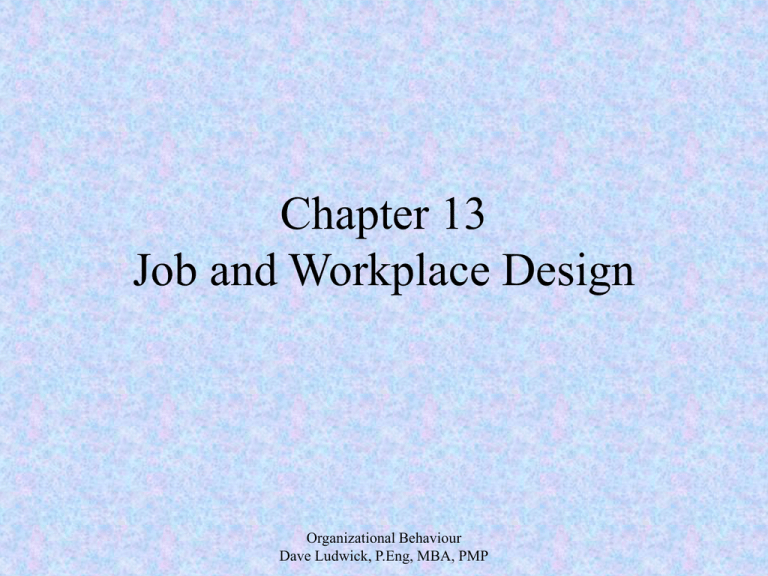
Chapter 13 Job and Workplace Design Organizational Behaviour Dave Ludwick, P.Eng, MBA, PMP What makes a good job? • Thinking about your career so far, what has been your best job? Why? • How about worst job? Why? • What are the patterns? Organizational Behaviour Dave Ludwick, P.Eng, MBA, PMP Job Characteristics Model • Hackman and Oldham developed the Job Characteristics Model (JCM) to try to determine what makes a good job • They considered 5 elements of a job – Skill Variety – the variety of skills required for the job – Task Identity – the completion of a whole identifiable piece of work – Task Significance – the degree of impact the job has on the lives and work of others – Autonomy – Amount of freedom, independence, discretion in the job – Feedback – amount of info about the effectiveness of performance Organizational Behaviour Dave Ludwick, P.Eng, MBA, PMP Lets rate 3 Jobs with the JCM Physician Software Developer Skill Variety Task Identity Task Significance Autonomy Feedback Total Organizational Behaviour Dave Ludwick, P.Eng, MBA, PMP Executive Assistant Job Characteristics Model • Combining the 5 elements with these 3 psychological states predicts an employees motivation – Experienced Meaningfulness – the more meaningful a job is, the more the employee sees the job as important and worthwhile – Experienced Responsibility – the more autonomy a job has, the more personal responsibility is felt by the employee – Knowledge of Results – feedback helps employees know whether they are performing effectively • Motivating Potential Score (p. xxx) – an equation that calculates a job’s motivating characteristics and shows how it can be altered to improve motivation • Lets try the exercise (p 521) Organizational Behaviour Dave Ludwick, P.Eng, MBA, PMP Gung Ho! • Ken Blanchard and Sheldon Bowles put these 3 psychological states into their book Gung Ho! – The Spirit of the Squirrel – Worthwhile Work fulfills God’s plan for the forest – The Way of the Beaver – Employees are in control of achieving their goal, which fulfills God’s plan for the Beaver – The Gift of the Goose – Employees cheer each other on, which provides feedback and encouragement, God’s gift to each other Organizational Behaviour Dave Ludwick, P.Eng, MBA, PMP Job Design • Job Design is how tasks are arranged to form a job • A job is a set of tasks performed by one person. The more tasks a job has, the greater the skills required • Building an enjoyable job out of an existing one should consider these 3 ideas – Job Rotation – Job Enlargement – Job Enrichment Organizational Behaviour Dave Ludwick, P.Eng, MBA, PMP Job Design • Job Rotation – Also known as cross-training – Temporarily rotating employees onto other jobs at the same level, which are somewhat related or connected to their original job – This provides benefits to the organization in that it expands the trained base of employees for a set of jobs – It also reduces reliance on any one individual for a specific job – Also provides improved motivation, variety, reduces boredom and expands an employees skill set. This is an especially useful tactic in highly specialized work environments – Some costs are that job rotation does increase training costs, and may create some disruption Organizational Behaviour Dave Ludwick, P.Eng, MBA, PMP Job Design • Job Enlargement – Involves expanding the job horizontally (within the same job context), by increasing the number and variety of tasks in a job • Example: A receptionist is originally responsible for answering the phone and creating guests at the front door, but is then made responsible for booking boardrooms and audio/visual equipment – With more tasks covered by an individual, the number of employees can be reduced Organizational Behaviour Dave Ludwick, P.Eng, MBA, PMP Job Design • Job Enrichment – Job enrichment involves expanding the job vertically, such that the employee’s responsibility includes the planning, execution and evaluation of the role in its entirety – Workers can then do a more complete aspect of a task (such as building a complete product or providing a complete service), increasing the degree to which they identify with a task, the significance of the task and the feedback they receive from the complete outcome Organizational Behaviour Dave Ludwick, P.Eng, MBA, PMP Workplace Design • Popular lists such as Canada’s Top 50 Best Places to Work are an annual competition for companies to show case their workplace to prospective employees • Top companies have very little difference between them • Generally, they all feature listening to employees, flextime, communicating about business, subsidized meals, and diversity in work force as benefits • The Best companies support a learning career, career development, and have strong training programs with some tangible financial (usually matching programs) contribution • Top companies use regular 360 Degree reviews to provide objective performance appraisals Organizational Behaviour Dave Ludwick, P.Eng, MBA, PMP Workplace Design • One of the most popular features top companies offer these days is flexibility • While once only offered in knowledge-oriented organizations, flexibility is surfacing in a number of wasy in more companies • Flexibility shows up in the form of: – – – – Flexible work schedules (with established core hours of operation) Compressed work weeks Job sharing Telecommuting • Many families opt to have one person work 4 days a week on reduced salary to accommodate home interests and obligations Organizational Behaviour Dave Ludwick, P.Eng, MBA, PMP Job Sharing • Job Sharing allows an organization to draw on the talents of more than one person at the price of one. • Job sharing also provides flexibility to job owners, making a meaningful career an option when full-time employment is not possible • Similarly for employers, job sharing may give access to talent that is otherwise unavailable due to other commitments Organizational Behaviour Dave Ludwick, P.Eng, MBA, PMP Telecommuting • Telecommuting is defined as when employees do their work away from the main office at least2 days a week • Telecommuting suits independent jobs, routine jobs, mobile activities and knowledge jobs • Telecommuting is a great way to remain productive by avoiding office chit chat • But, employees can miss out on decision making that gets made around the water-cooler – out of sight out of mind • Some telecommuters also indicate that the isolation can be too much. Thus where possible, employees should visit the office regularly Organizational Behaviour Dave Ludwick, P.Eng, MBA, PMP Workspaces • Workspace design often refers to the physical design of the work area within a building • Office size has traditionally been a status symbol, but with recent cost cutting, stats say office sizes have dropped 25 to 50% • Office arrangement refers to the amount of space between employees – Influences the amount of socialization, conversation, formality and openness • Feng Shui – a Chinese system for arranging a person’s surroundings to build harmony and balance – Goal is to build and balance chi, the life force – Considers office location, layout, desk position, water, plants and flowers in designing a workspace Organizational Behaviour Dave Ludwick, P.Eng, MBA, PMP Hotelling • Hotelling refers to the concept where employees do arrive at the main office daily, but do not own a specific spot to work. • Offices, desks, conference rooms are booked in advance • Hotelling combined with telecommuting helps employers reduce office costs • Email and cell phones ensure people stay in touch Organizational Behaviour Dave Ludwick, P.Eng, MBA, PMP Developing Careers • Career – the evolving sequence of a person’s work experience, regardless of success, failure paid or unpaid • Organizations benefit from a defined career development program because they help to ensure the right people will be available to meet future needs • Career development is not a defined plan for the employee as it was 25 years ago. – Rather it now takes the form of giving the employee time and financial support so they can acquire skills to direct their own career Organizational Behaviour Dave Ludwick, P.Eng, MBA, PMP Suggestions for Career maintenance • Maintain employability with a good continuous work history • Have a fall back position where possible • Know your skills • Market yourself, keep your eyes open • Act Type A but be Type B • Stay culturally current, be in the know • Be a compelling communicator • Manage your finances and have a rainy day reserve • Be capable of rewarding yourself • Be self-aware, but also be a team player Organizational Behaviour Dave Ludwick, P.Eng, MBA, PMP Developing your own Career Plan • Step 1: Sit back, relax, and think about where you are, what you are doing, who you are in 30 years • Step 2: What would it take (financially, spiritually, physical health, educationally, relationship-wise) to get there? • Step 3: Do you currently have the necessary means through which to get there? If yes, great, continue on. • Step 4: If not, what does a life plan look like (with milestone posts every 5 years) that helps you track to achieve this goal? • Concerns (also known as whinings): – I can’t predict what will happen to me over 30 years, so I can’t plan – My interests and goals may change over 30 years, so there is no sense in a plan Organizational Behaviour Dave Ludwick, P.Eng, MBA, PMP Vocation/Purpose vs. Job • For many people, a job is: – a source of income – a place of belonging • For more of us, it needs to be: – A place where we fulfill ourselves – A place where achieve fulfill our role in the universe – A place where we act out our part in this great plan • What if your job was your purpose? What if you could pick the job so it was not just an income source but also fulfilled your vocation? – Things would be simpler, decisions would be easier, because your choices would be made in the light of your purpose Organizational Behaviour Dave Ludwick, P.Eng, MBA, PMP Thinking it over… • • • • How do you benefit by NOT taking action? How do you suffer by NOT taking action? How do you benefit by taking action? How do you suffer by taking action? • Breakdown goal into successive goals • Breakdown skills/experience into successive requirements • Breakdown skills/experience requirements into a timeline and plan • Anything you can conceive and believe you can achieve can be achieved • With every idea God provides an equivalent means by which to achieve it. • Chapter 14 Organizational Behaviour Dave Ludwick, P.Eng, MBA, PMP
